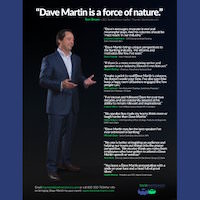 |
 |
"When something goes wrong in your life just yell 'PLOT TWIST' and move on." » Molly Weis
Undrafted Day
It’s the time of year for one of my favorite sporting events: the NFL Draft. I admire how the NFL turns an HR event into a 3-day TV series.
One of the things I most enjoy about it is that fans from around the country are filled with hope at draft time. Even teams coming off a bad season…or seasons… have just a glimmer of hope right now.
From a business perspective, the seriousness of the NFL draft is a reminder of a key truth. Business success is driven first and foremost by getting the right people on your team. Solid brands are great. Talented leaders are awesome to have. Smart strategies are wonderful.
But brands, leadership, and strategies aren’t enough without having the right people on (or in) the field.
That said, it’s another aspect of the draft that I often cite when discussing resilience with bankers.
For every person thrilled to be drafted, there are just as many dealing with serious disappointment. Sometimes a player “falls in the draft” and isn’t chosen as high as hoped.
Many are told by teams that there is serious interest in them. And then, the phone doesn’t ring.
In as many cases, young men who have spent their entire lives attempting to make the NFL go undrafted.
After one of the most exhaustive talent evaluations of any industry (scouting, film review, “pro days”, the NFL combines, individual interviews, etc.) many are left on the outside looking in.
Yet, even after some of the most public rejections imaginable, the road does not necessarily end.
Stars such as Kurt Warner, Wes Welker, Antonio Gates, Priest Holmes, Warren Moon, John Randle, and Nate Newton were all undrafted out of college. (If you know who these guys are, you know.)
On an immensely important day in their lives, they were passed on. But situations can… and do… change.
Opportunities that weren’t available before suddenly materialize. Life is not static.
While most of us never go through something as public and stark as a “draft”, we are chosen (or not) by customers, prospects, and employers on a regular basis.
Sometimes, it’s not your day. But tomorrow may be.
Each of our personal roads to success are unique. Some may appear smoother, but all deal with detours along the way.
Always remember that it’s the work we put in on - and after - disappointing days that makes our future great days possible.
Always Good to See You
A couple of articles I’ve come across lately have reinforced my beliefs in the vital roles bank branches and live bankers will continue to play into the future.
And, yes, I do realize that it can seem counterintuitive to make that case while the banking world becomes more technology driven by the day.
Yet, it’s the quickening speed of advancement in certain technologies that have me more convinced than ever.
In a recent column and video for the Wall Street Journal, columnist Joanna Stern conducted an interesting experiment.
For the piece entitled, “I Cloned Myself with AI. She Fooled my Bank and My Family,” she worked with a few companies now offering various artificial intelligence products and services.
One of these AI functions clones a person’s voice.
It can listen to recorded samples of a person’s voice from something as common as a social media post and effectively clone it.
She was then able to use that voice simulation on her bank’s phone system. That system uses voice recognition for customer identification for account access.
The cloned voice was good enough to give access to her account.
Those kinds of exercises are both impressive and somewhat terrifying.
Apparently, video cloning that can fool most folks on a video call is almost here, as well.
I don’t pretend to know what the final answers will be to reliable security in the brave new world we are entering, but something tells me that physical, face-to-face conversations and transactions will play a larger role than most pundits may have thought.
Survey results recently released by Accenture on customer attitudes about branch presence were eye opening, as well.
Their findings showed that customers from all generations had strong preferences to seeing their banks’ branches in their neighborhoods.
It may surprise some to learn that the highest percentages were found from 18 to 44 years of age.
Yes, even younger people strongly favor convenient branch access as it visually signals their bank's stability and availability.
In a world in which customers (and culprits pretending to be) can access every financial institution on the planet from the palms of their hands, the physical presence of accessible, skilled, and helpful bankers differentiates more than ever.
Strive to be one of your company's true differentiators today.









